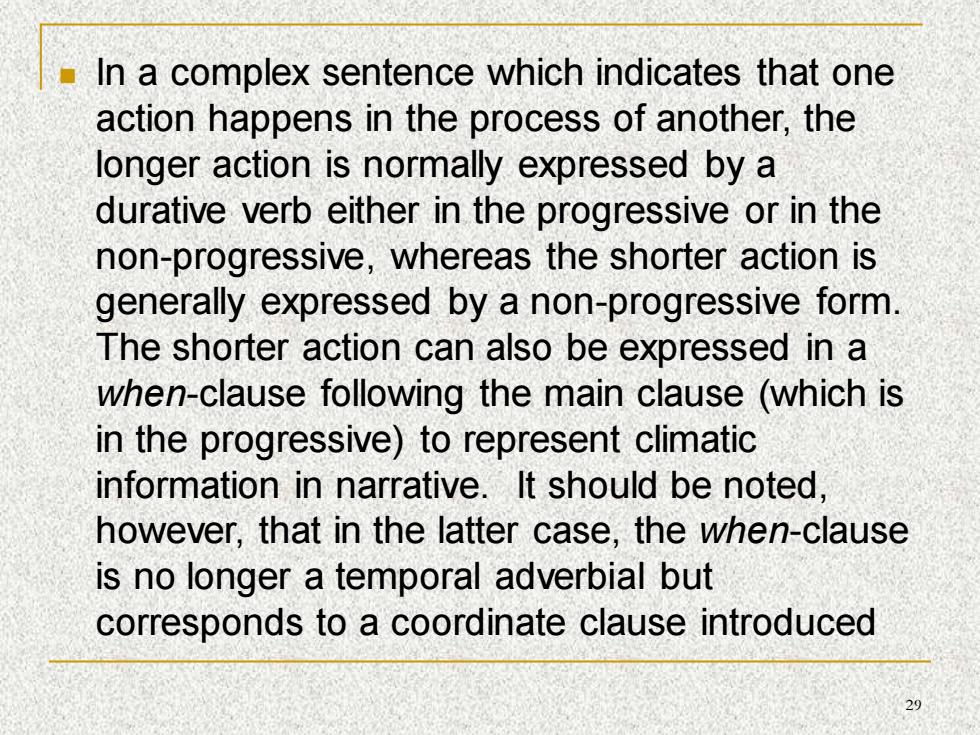
>2)Some few notes on adverbial clauses It may be useful to give some few notes on the principal uses of adverbial clauses left undiscussed so far. A)Adverbial clauses of time Adverbial clauses of time introduced by when,while, as,before,after,and until can be described in terms of“same time?",“earlier time",and“later time”. a)Same time By“same time'”here we mean the happening of two simultaneous events.If the two actions are reiterative(反复的)or habitual,the temporal clause can be introduced by when or whenever and the
26 ➢ 2)Some few notes on adverbial clauses ◼ It may be useful to give some few notes on the principal uses of adverbial clauses left undiscussed so far. A) Adverbial clauses of time Adverbial clauses of time introduced by when, while, as, before, after, and until can be described in terms of “same time”, “earlier time”, and “later time”. ◼ a) Same time By “same time” here we mean the happening of two simultaneous events. If the two actions are reiterative(反复的) or habitual, the temporal clause can be introduced by when or whenever and the

verbs occur in the simple present or the simple past in both the adverbial and the main clause. The habitual use of a when-/whenever-clause is interchangeable with an if-clause used in the same sense,eg: When(ever)he goes to town,he visits his aunt. She felt ill when (ever)she ate oyster. If he goes to town,he brings us a present. When (ever)he goes to town... If the two actions are durative and last for an equal length of time,the temporal clause can be introduced by when or while and the verbs in both the adverbial and the main clause may occur in the simple past or the past progressive
27 verbs occur in the simple present or the simple past in both the adverbial and the main clause. The habitual use of a when- / whenever-clause is interchangeable with an if-clause used in the same sense, eg: When (ever) he goes to town, he visits his aunt. She felt ill when (ever) she ate oyster. If he goes to town, he brings us a present. = When (ever) he goes to town… ◼ If the two actions are durative and last for an equal length of time, the temporal clause can be introduced by when or while and the verbs in both the adverbial and the main clause may occur in the simple past or the past progressive

It is also possible to use as long as to spotlight (强调)the exactly equal length of time,eg: The wind blew hard when the rain poured down. I was cooking the dinner while he was playing the piano. He worked as long as we played. 在我们工作的时候他玩儿。 In a complex sentence denoting two simultaneous short actions,the temporal clause may be introduced by when,as soon as,just as, the instant,the moment,directly,immediately, etc.It is also possible to use hardly/ scarcely...when and no sooner...than,eg: The dog barked the instant it heard a noise. I had hard/y left when the quarrel started
28 It is also possible to use as long as to spotlight (强调)the exactly equal length of time, eg: The wind blew hard when the rain poured down. I was cooking the dinner while he was playing the piano. He worked as long as we played. 在我们工作的时候他玩儿。 ◼ In a complex sentence denoting two simultaneous short actions, the temporal clause may be introduced by when, as soon as, just as, the instant, the moment, directly ,immediately, etc. It is also possible to use hardly / scarcely…when and no sooner … than, eg: The dog barked the instant it heard a noise. I had hardly left when the quarrel started

In a complex sentence which indicates that one action happens in the process of another,the longer action is normally expressed by a durative verb either in the progressive or in the non-progressive,whereas the shorter action is generally expressed by a non-progressive form. The shorter action can also be expressed in a when-clause following the main clause(which is in the progressive)to represent climatic information in narrative.It should be noted, however,that in the latter case,the when-clause is no longer a temporal adverbial but corresponds to a coordinate clause introduced
29 ◼ In a complex sentence which indicates that one action happens in the process of another, the longer action is normally expressed by a durative verb either in the progressive or in the non-progressive, whereas the shorter action is generally expressed by a non-progressive form. The shorter action can also be expressed in a when-clause following the main clause (which is in the progressive) to represent climatic information in narrative. It should be noted, however, that in the latter case, the when-clause is no longer a temporal adverbial but corresponds to a coordinate clause introduced

by"and (just)at that moment",eg: When we arrived,she was cooking the dinner. I broke a glass while I was cleaning the room. I was cleaning the room when I broke a glass. =I was cleaning the room,and just at that time I broke a glass. b)Earlier time and later time These terms are concerned with two or more actions happening one after another.This kind of temporal relationships can be expressed by these semantically-related subordinators: before,after,till,until,when,since,etc.eg: She looked both ways before she crossed the road
30 by “and (just) at that moment”, eg: When we arrived, she was cooking the dinner. I broke a glass while I was cleaning the room. I was cleaning the room when I broke a glass. = I was cleaning the room, and just at that time I broke a glass. ◼ b) Earlier time and later time ◼ These terms are concerned with two or more actions happening one after another. This kind of temporal relationships can be expressed by these semantically-related subordinators: before, after, till, until, when, since, etc. eg: She looked both ways before she crossed the road